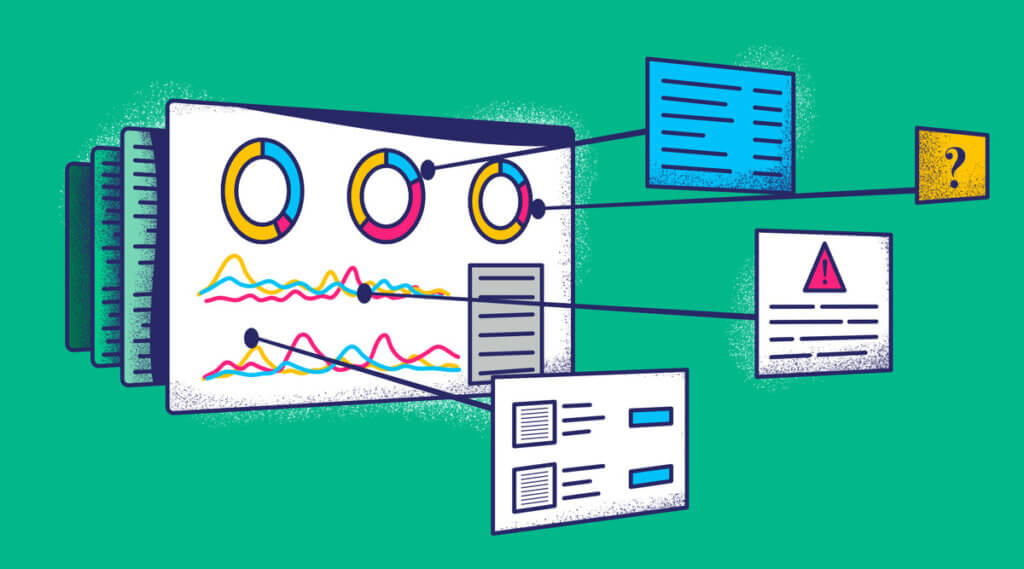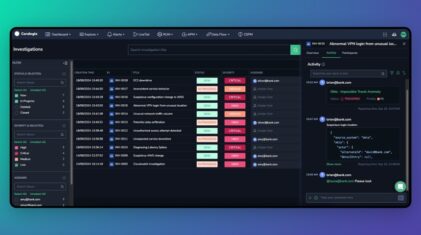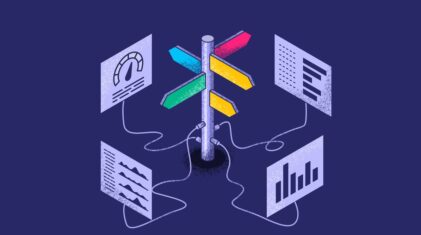Monitoring is asking your system questions about its current state. Usually these are performance related, and there are many open source enterprise monitoring tools available. Many of those available are also specialized. There are tools specifically catering to application monitoring, cloud monitoring, container monitoring, network infrastructure… the list is endless, regardless of the languages and tools in your stack.
Observability is taking the data from your monitoring stack and using it to ask new questions of your system. Examples include finding and highlighting key problem areas or identifying parts of your system that can be optimized. A system performance management stack built with observability as a focus enables you to then apply the answers to those questions in the form of a refined monitoring stack.
Observability and Monitoring are viewed by many as interchangeable terms. This is not the case. While they are interlinked, they are not interchangeable. There are actually very clear and defined differences between them.
Why You Need Both Observability and Monitoring
You can see why Observability and Monitoring are so often grouped together. When done properly, your Observability and Monitoring stacks will operate in a fluid cycle. Your Monitoring stack provides you with detailed system data, your Observability stack turns these analytics into insights, those insights are in turn applied to your Monitoring stack to enable it to produce better data.
What you gain from this process is straightforward – visibility.
System visibility in any kind of modern software development is absolutely vital. With development life-cycles becoming evermore defined by CI/CD, containerization, and complex architectures like microservices, contemporary engineers are tasked with keeping watch over an unprecedented amount of sources for potential error.
The best Observability tools in the world can provide little to no useful analysis if they’re not being fed by data from a solid Monitoring stack. Conversely, a Monitoring stack does little but clog up your data storage with endless streams of metrics if there’s no Observability tooling present to collect and refine the data.
It is only by combining the two that system visibility reaches a level which can provide a quick picture of where your system is and where it could be. You need this dual perspective, too, as in today’s forever advancing technical landscape no system is the same for long.
More Progress, More Problems
Without strong Observability and Monitoring, you could be only 1-2 configurations or updates away from a system-wide outage. This only becomes more true as your system expands and new processes are implemented. Growth brings progress, and in turn, progress brings further growth.
From a business perspective this is what you want. If your task is to keep the tech your business relies on running smoothly, however, growth and progress mean more systems and services to oversee. They also mean change. Not only will there be more to observe and monitor, but it will be continually different. The stack your enterprise relies on in the beginning will be radically different five years into operation.
Understanding where monitoring and observability differ is essential if you don’t want exponential growth and change to cause huge problems in the future of your development life-cycle or BAU operations.
Only through an established and healthy monitoring practice can your observability tools provide the insights needed to preempt how impending changes and implementations will affect the overall system. Conversely, only with solid observability tooling can you ensure the metrics you’re tracking are relevant to the current state of the system infrastructure.
A Lesson From History
Consider the advent of commercially available cloud computing and virtual networks. Moving over to Azure or AWS brought many obvious benefits. However, for some, it also brought a lot of hurdles and headaches.
Why?
Their Observability and Monitoring stacks were flawed. Some weren’t monitoring those parts of their system which would be put under strain from the sudden spike in internet usage, or were still relying on Monitoring stacks built at a time when most activity happened on external servers. Others refashioned their monitoring stacks accordingly but, due to lack of Observability tools, had little-to-no visibility over parts of their system that extended into the cloud.
Continuous Monitoring/Continuous Observability
DevOps methodology has spread rapidly over the last decade. As such, the implementation of CI/CD pipelines has become synonymous with growth and scaling. There are many advantages of Continuous Implementation/Continuous Development, but at their core, CI/CD pipelines are favored because they enable a rapid release approach to development.
Rapid release is great from a business perspective. It allows the creation of more products, faster, which can be updated and re-released with little-to-no disruption to performance. On the technical side, this means constant changes. If a CI/CD pipeline process isn’t correctly monitored and observed then it can’t be controlled. All of these changes need to be tracked, and their implications on the wider system need to be fully understood.
Rapid Release – Don’t Run With Your Eyes Shut
There are plenty of continuous monitoring/observability solutions on the market. Investing in specific tooling for this purpose in a CI/CD environment is highly recommended. In complex modern development, Observability and Monitoring mean more than simply tracking APM metrics.
Metrics such as how many builds are run, and how frequently, must be tracked. Vulnerability becomes a higher priority as more components equal more weak points. The pace at which vulnerability-creating faults are detected must keep up with the rapid deployment of new components and code. Preemptive alerting and real-time traceability become essential, as your development life-cycle inevitably becomes tied to the health of your CI/CD pipeline.
These are just a few examples of Observability and Monitoring challenges that a high-frequency CI/CD environment can create. The ones which are relevant to you will entirely depend on your specific project. These can only be revealed if both your Observability and Monitoring stacks are strong. Only then will you have the visibility to freely interrogate your system at a speed that keeps up with quick-fire changes that rapid-release models like CI/CD bring.
Back to Basics
Complex system architectures like cloud-based microservices are now common practice, and rapid release automated CI/CD pipelines are near industry standards. With that, it’s easy to overcomplicate your life cycle. Your Observability and Monitoring stack should be the foundation of simplicity that ensures this complexity doesn’t plunge your system into chaos.
As much as there is much to consider, it doesn’t have to be complicated. Stick to the fundamental principles. Whatever shape your infrastructure takes, as long as you are able to maintain visibility and interrogate your system at any stage in development or operation you’ll be able to reduce outages and predict the challenges any changes bring.
The specifics of how this is implemented may be complex. The goal, the reason you’re implementing them, is not. You’re ensuring you don’t fall behind change and complexity by creating means to take a step back and gain perspective.
Observability and Monitoring – Which Do You Need To Work On?
As you can see, Observability and Monitoring both need to be considered individually. While they work in tandem, each has a specific function. If the function of one is substandard, the other will suffer.
To summarize, monitoring is the process of harvesting quantitative data from your system. This data will take the form of many different metrics (query, error, processing, events, traces etc). Monitoring is asking questions of your system. If you know what it is you want to know, but your data isn’t providing the answer from your system, your Monitoring stack that needs work.
Observability is the process of transforming collected data into analysis and insight. It is the process of using existing data to discover and inform what changes may be needed and which metrics should be tracked in the future. If you are unsure what it is you should be asking when interrogating your system, Observability should be your focus.
Remember, as with all technology, there is never a ‘job done’ moment when it comes to Observability and Monitoring. It is a continuous process, and your stacks, tools, platforms, and systems relating to both should be constantly evolving and changing. This piece lists but a few of the factors software companies of all sizes should be considering during the development life-cycle.




